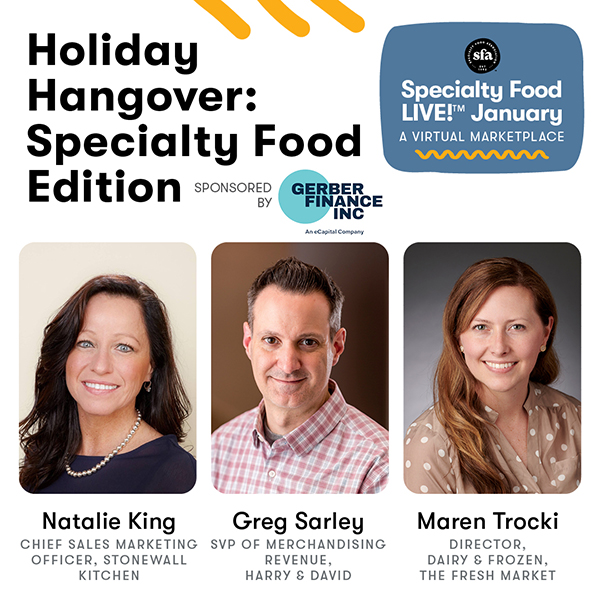Despite a second wave of the pandemic and continuing supply chain issues, the 2020 holiday season was especially successful for specialty food makers and retailers. During a panel discussion during Specialty Food Live!, Thursday, industry stakeholders shared their successes and struggles during these unprecedented time. The panel included Natalie King, chief sales marketing officer at Stonewall Kitchen, Maren Trocki, director of dairy and frozen at The Fresh Market, and Greg Sarley, SVP of merchandising revenue at Harry & David.
Throughout the year, Stonewall Kitchen saw a huge uptick in sales across every one of its categories as consumers continued to work and eat at home full time. According to King, products like hand soap, candles, drink mixers, meal starters, and baking mixes in particular, saw huge success. Direct-to-consumer sale was the main driver for this; though it makes up only 21 percent of total company sales normally, it was up 90 percent over last year and, in December alone, Stonewall Kitchen had $10 million in sales in the channel. The company’s wholesale division, which represents the majority of its total sales, saw a 12 percent increase, with grocery sales easily offsetting the decline in mom and pop/department store business.
King anticipates sales to remain strong into 2021 and beyond, noting that people have fallen in love with cooking again and are consistently seeking out specialty products to spice up their daily routines.
Greensboro, North Carolina-based The Fresh Market began ramping up for the holiday season in the spring, anticipating 30 to 40 percent growth, Trocki said. However, by the time summer came around, it was clear that number would need to be adjusted because volume was not slowing down.
According to Trocki, December 23 was the biggest day for dairy and grocery sales in the history of The Fresh Market, including a time when the grocer had 16 additional stores. The grocer’s planning was worth it. “Overall, we were in a better stock position than we predicted, especially with things like butter and eggs, which we thought would be in shorter supply,” Trocki said.
At Harry & David, Sarley saw an increase in consumer demand around products that would help make the holidays easier. “A lot of people were adjusting their plans last minute,” he said. “People were looking for a break, and we offered them products that would help.”
He also noted that this holiday season brought with it new and younger customers looking to send food gifts for the first time. “Food is a great way to shift from traditional gift giving to more experiential gift giving,” Sarley explained.
Overcoming Supply Chain Issues
Stonewall Kitchen’s wholesale business peak is around September; three months earlier than the peak for its direct-to-consumer business. Because of this, many products were out of inventory before DTC sales had even begun, said King. Luckily, the company had forecasted 30 to 50 percent more product for the holiday season, so the deficit wasn’t as bad as it could have been, she said.
To help deal with the increased demand, Stonewall Kitchen ramped up production, eliminated promotions, and had to substitute some packaging materials. "I would rather have something temporary, like a blue cap instead of a white cap, than face an out-of-stock."
Going forward, Stonewall is looking at capacity improvements to increase output at its three manufacturing facilities in Vermont and Maine. “I think it’s a long term investment, but we need to make it happen fairly quickly in order to meet demand,” said King. “At this point right now, we’re basing our business on the fact that this demand isn’t going away.”
For manufacturers struggling with their supply chain, Sarley recommended identifying the partners that will be able to come through for you, but also having backups for any issues that arise. “How are you able to react faster to trends that change? You have to have more options. I think you’ll see a lot of bigger retailers broaden their supplier base to have more options.”
Related: 5 Steps to Gathering Consumer Insights; Disruptors Empower Consumers to Be Better Than Normal.

